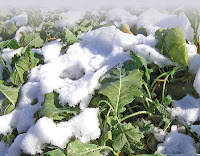A few
years ago, my son purchased 300 acres of
hunting land in northwestern Wisconsin.
His goal was to develop it into a future
home for a healthy deer herd. It would
then become a place where he, his twin 4-year-old
sons and his dad could successfully hunt
for many years. Although we couldn’t wait
to dig in, we had no idea as to the amount of work it would take to get the property in the condition we imagined for the future. The
first thing we needed to do was clear
some strategically located food plots —
six in total.
After clearing those the
first spring, it was time to prepare them
for planting. We tested the plots and then
added the correct amount of lime and fertilizer
to provide the perfect soil conditions. We decided to try seed from six of the better
known names in food plot seeds. We
planted in late spring and again in
August, trying to experiment with as
many seeds as possible. Much of northwestern
Wisconsin consists of light, sandy soil,
so we needed to be mindful of the dry conditions when selecting our seeds.
That first September, we noticed one of our brassica plots was growing extremely well.
That said, the deer did not seem to be
feeding in it early on. It grew to 12 to
14-inches high the next few weeks, and
then we finally had our first hard frost.
During the next two weeks, the entire food
plot had been consumed. We realized we had a seed we were looking for. We also realized as long as the seed received a moderate rainfall
in August or September, we would get the
growth
Winter-Greens
is head and shoulders above any food plot seed we have ever used. We plant
Winter- Greens about Aug. 10 here in Wisconsin. It’s recommended to plant about
60 days before the projected first frost.
Winter-Greens is a brassica, and brassicas should not be used in the
same food plot in back-to-back plantings. However, if you plant alternative
seeds in spring, follow it up with brassica again in August. That works quite
well. We have used this method with great
success. We had pictures of the buck
shown in this article as early as this past year. When he showed up this year
on camera, we got some great close-ups to see that he had at least 17 scorable
points. Every photo we had the previous year, as well as thus far this year,
had been after dark. We needed to get
him on those food plots during daylight.
After bow hunting him for the past two years, with no daytime pictures,
we realized that we were simply educating him as to our location in the area. About
two weeks before our gun season, we decided to leave him alone. Less than two
weeks later, we finally got him on camera at 8:15 a.m. before gun season. Four
days later, he walked out on one of our Winter-Greens food plots and started
feeding. A well-placed shot dropped him where he was standing. We are firm believers
that food trumps many things in the deer’s world. When hunting the rut, bucks
will be where the does are, and the does will eventually be where the food is.
What that says is that even in the rut, food trumps everything.
In conclusion, if you are trying to figure
out what works best on your food plots, don’t overlook the potential of a
planting of Whitetail Institute’s Winter-Greens.
Thank you Whitetail Institute for
contributing in a major way to our success.


